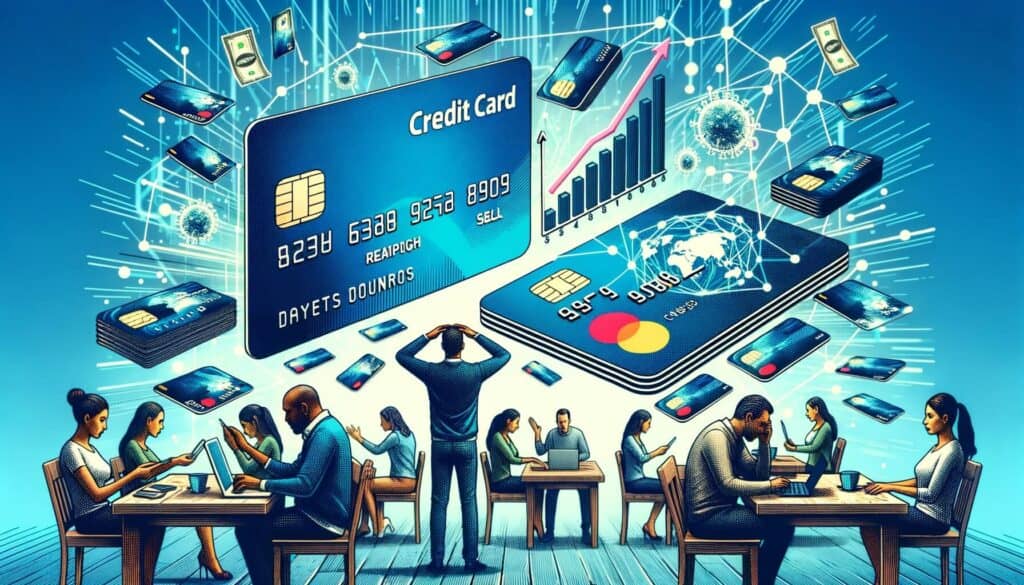
By Amanda Hoglund January 11, 2025
Credit card processing outages can be a nightmare for businesses, causing frustration for both merchants and customers. These outages occur when the system that processes credit card transactions experiences a disruption, preventing businesses from accepting payments.
In today’s digital age, where cash transactions are becoming less common, credit card processing outages can have a significant impact on a business’s bottom line. In this article, we will explore the causes of credit card processing outages, their impact on businesses, and how to prevent and troubleshoot these issues.
The Impact of Credit Card Processing Outages on Businesses

Credit card processing outages can have severe consequences for businesses, both financially and in terms of customer satisfaction. When a business is unable to process credit card payments, it can result in lost sales and revenue. According to a study conducted by Javelin Strategy & Research, businesses in the United States lose an estimated $4.5 billion annually due to payment system outages. This loss of revenue can be particularly detrimental for small businesses that heavily rely on credit card transactions.
In addition to financial losses, credit card processing outages can also damage a business’s reputation. Customers expect seamless and convenient payment options, and when they encounter issues with credit card processing, it can lead to frustration and dissatisfaction. Negative experiences can result in customers taking their business elsewhere, potentially causing long-term damage to a business’s customer base.
Common Causes of Credit Card Processing Outages

There are several common causes of credit card processing outages that businesses should be aware of. One of the primary causes is system failures or technical glitches. This can occur due to hardware malfunctions, software bugs, or network connectivity issues. For example, a power outage or a server crash can disrupt the processing system, rendering it temporarily unavailable.
Another common cause of credit card processing outages is cyberattacks. Hackers may target payment systems to steal sensitive customer information or disrupt operations. These attacks can range from Distributed Denial of Service (DDoS) attacks, which overwhelm the system with traffic, to more sophisticated methods like malware injections or data breaches.
Furthermore, human error can also contribute to credit card processing outages. Mistakes made during system updates or configuration changes can lead to disruptions in the processing system. Additionally, inadequate maintenance or outdated software can make the system vulnerable to outages.
Preventive Measures: How to Minimize the Risk of Outages

While it may not be possible to completely eliminate the risk of credit card processing outages, there are several preventive measures businesses can take to minimize the likelihood and impact of these disruptions.
First and foremost, businesses should invest in reliable and robust payment processing systems. This includes regularly updating hardware and software, as well as implementing security measures to protect against cyberattacks. It is crucial to work with reputable payment processors that have a proven track record of reliability and security.
Regular system maintenance and testing are also essential to identify and address any potential issues before they escalate into outages. This includes monitoring network connectivity, performing software updates, and conducting regular security audits. By proactively addressing vulnerabilities, businesses can reduce the risk of outages.
Additionally, businesses should have backup plans in place in case of an outage. This can include alternative payment methods, such as mobile payment solutions or manual credit card imprinters. Having contingency plans ensures that businesses can continue to accept payments even during an outage, minimizing the impact on sales and customer satisfaction.
Troubleshooting Credit Card Processing Outages: Step-by-Step Guide
Despite taking preventive measures, credit card processing outages can still occur. When faced with an outage, it is crucial for businesses to act quickly to minimize the disruption. Here is a step-by-step guide to troubleshooting credit card processing outages:
1. Identify the issue: Determine whether the outage is specific to your business or if it is a widespread issue affecting multiple merchants. This can be done by contacting your payment processor or checking for any public announcements or alerts.
2. Check hardware and connectivity: Ensure that all hardware components, such as card readers and terminals, are properly connected and functioning. Verify that there are no issues with your internet connection or network connectivity.
3. Restart the system: Sometimes, a simple system restart can resolve minor glitches or temporary issues. Power off all devices involved in the payment processing system, including card readers, terminals, and routers. Wait for a few minutes before powering them back on.
4. Contact your payment processor: If the issue persists, contact your payment processor’s customer support. Provide them with detailed information about the problem, including any error messages or codes displayed on the payment devices. They will be able to assist you in troubleshooting the issue further.
5. Implement backup payment methods: If the outage is expected to last for an extended period, activate your backup payment methods. This can include accepting payments through mobile payment solutions or using manual credit card imprinters. Communicate these alternative payment options to your customers to minimize any inconvenience.
6. Keep customers informed: Communication is key during an outage. Inform your customers about the issue and any alternative payment methods available. Utilize various channels, such as social media, email, or in-store signage, to keep customers updated on the progress of resolving the issue.
7. Monitor the situation: Continuously monitor the status of the outage and stay in touch with your payment processor for updates. Once the issue is resolved, test the system thoroughly to ensure it is functioning correctly before resuming normal operations.
The Role of Payment Processors in Resolving Outages

Payment processors play a crucial role in resolving credit card processing outages. As the intermediary between businesses and financial institutions, payment processors are responsible for securely transmitting transaction data and authorizing payments. When an outage occurs, it is the payment processor’s responsibility to identify and resolve the issue promptly.
Payment processors typically have dedicated teams of technical experts who monitor the processing system 24/7. These teams are trained to identify and address any disruptions in real-time. They work closely with merchants to troubleshoot issues and provide guidance on resolving the outage.
In some cases, payment processors may have redundant systems or backup servers to ensure uninterrupted service. These redundancies help minimize the impact of outages by automatically switching to backup systems when the primary system experiences a disruption.
Communication Strategies: Keeping Customers Informed During Outages
During a credit card processing outage, effective communication with customers is crucial to minimize frustration and maintain trust. Here are some strategies for keeping customers informed:
1. Proactive communication: As soon as an outage occurs, businesses should proactively communicate with their customers. This can be done through various channels, such as social media, email, or SMS notifications. Provide clear and concise information about the issue, its impact, and any alternative payment methods available.
2. Real-time updates: Continuously update customers on the progress of resolving the issue. This can be done through regular social media posts, email updates, or automated phone messages. Transparency and timely updates help alleviate customer concerns and demonstrate that the business is actively working to resolve the problem.
3. Customer support: Ensure that your customer support team is well-informed about the outage and alternative payment methods. Train them to handle customer inquiries and provide assistance during the outage. Prompt and helpful customer support can go a long way in maintaining customer satisfaction.
4. Apologize and offer incentives: Acknowledge the inconvenience caused by the outage and apologize to your customers. Consider offering incentives, such as discounts or freebies, to compensate for any inconvenience. This gesture can help rebuild customer trust and loyalty.
Legal and Financial Implications of Credit Card Processing Outages
Credit card processing outages can have legal and financial implications for businesses. From a legal standpoint, businesses may be held liable for any damages or losses incurred by customers due to an outage. This can include reimbursement for lost funds, identity theft, or any other financial harm resulting from the outage.
To mitigate legal risks, businesses should ensure that they have appropriate insurance coverage, including cyber liability insurance. This type of insurance can provide financial protection in the event of a data breach or cyberattack that leads to an outage.
From a financial perspective, credit card processing outages can result in lost sales and revenue. This can have a significant impact on a business’s cash flow and profitability. To minimize the financial impact, businesses should have contingency plans in place, such as alternative payment methods or access to emergency funds.
Frequently Asked Questions (FAQs) about Credit Card Processing Outages
Q1. What should I do if my business experiences a credit card processing outage?
If your business experiences a credit card processing outage, follow the troubleshooting steps outlined in this article. Contact your payment processor’s customer support for assistance and implement backup payment methods if necessary.
Q2. How can I prevent credit card processing outages?
To prevent credit card processing outages, invest in reliable payment processing systems, regularly update hardware and software, and implement security measures to protect against cyberattacks. Conduct regular system maintenance and testing, and have backup plans in place in case of an outage.
Q3. How long do credit card processing outages typically last?
The duration of credit card processing outages can vary depending on the cause and the responsiveness of the payment processor. Minor glitches or technical issues may be resolved within minutes, while more significant disruptions may take several hours or even days to resolve.
Q4. Can credit card processing outages be avoided entirely?
While it may not be possible to completely eliminate the risk of credit card processing outages, businesses can take preventive measures to minimize the likelihood and impact of these disruptions. By investing in reliable systems, conducting regular maintenance, and having backup plans in place, businesses can significantly reduce the risk of outages.
Conclusion
Credit card processing outages can have a detrimental impact on businesses, causing financial losses and damaging customer satisfaction. Understanding the common causes of these outages and implementing preventive measures can help businesses minimize the risk and mitigate the impact.
By investing in reliable payment processing systems, conducting regular maintenance, and having backup plans in place, businesses can ensure seamless payment transactions and maintain customer trust. In the event of an outage, prompt troubleshooting, effective communication with customers, and collaboration with payment processors are essential to resolving the issue and minimizing the disruption.